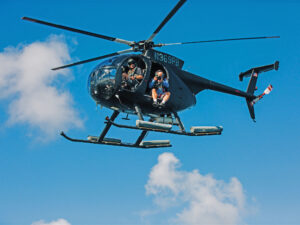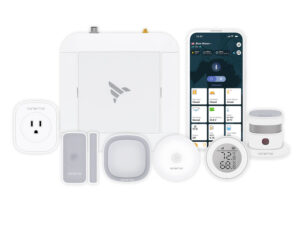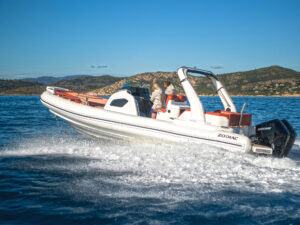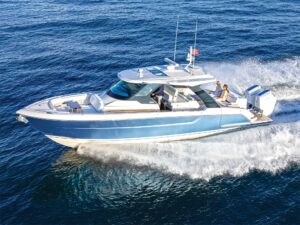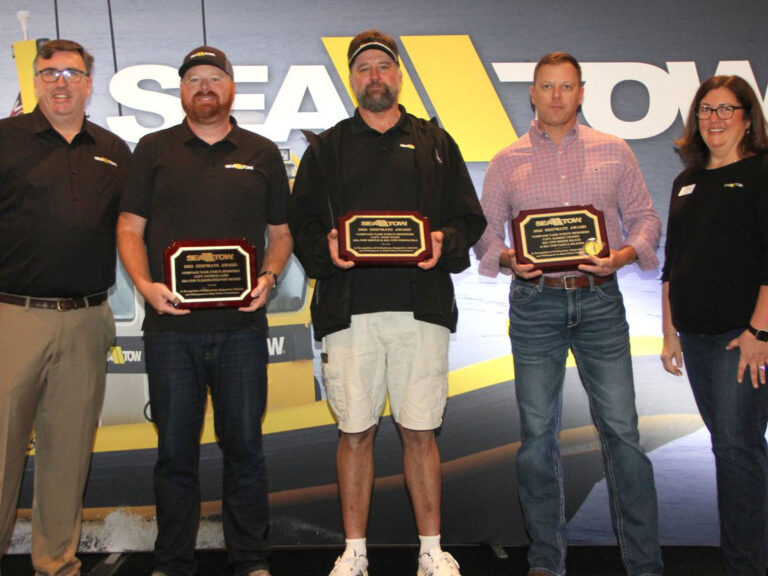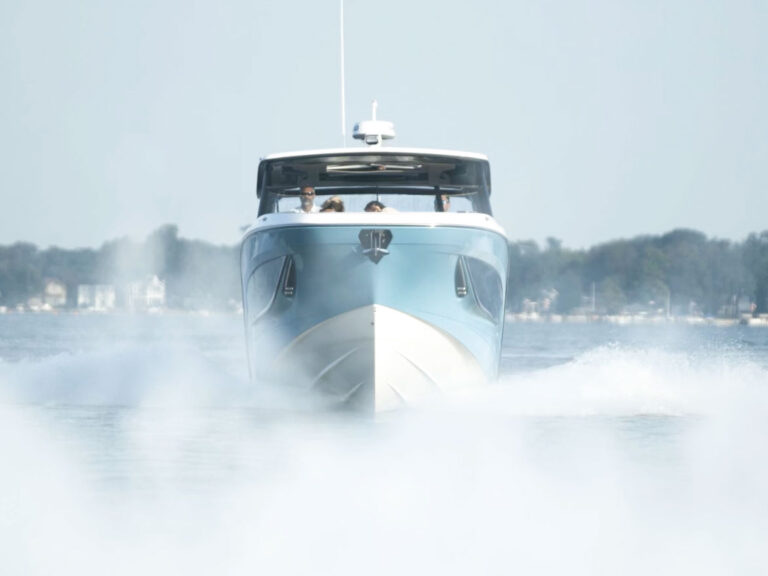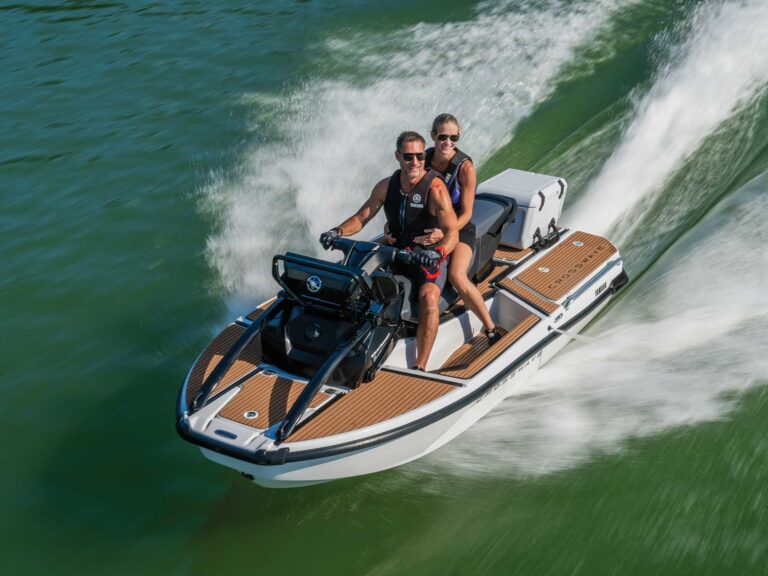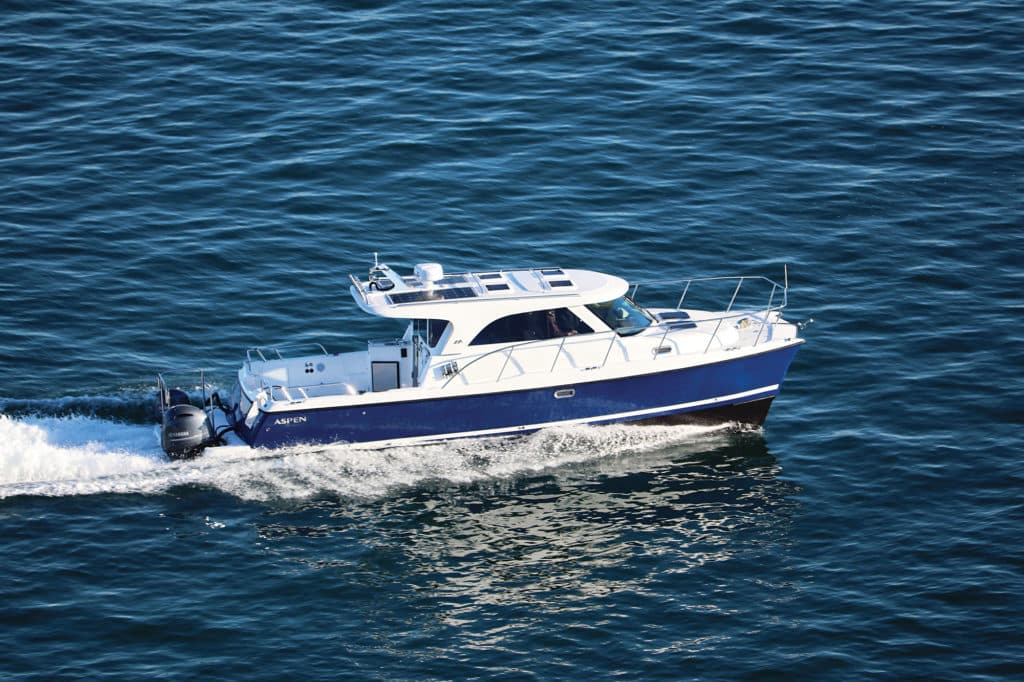
Aspen’s C107 jumps right out at boat buyers—it’s a power proa with asymmetrical hulls. Close inspection reveals that it delivers outstanding economy, exhibits excellence in rigging and construction, and is put together by people who really know boats.
But just what the heck is going on with two hulls of different sizes?
A catamaran is a boat with two hulls, used primarily because long and skinny hulls often prove easier-riding platforms than wider, shorter hulls. (Ever see a beamy go-fast boat?) The aspect of two skinny hulls connected by a deck often delivers excellent ride quality and a beamier boat overall, compared with a monohulled boat. Naval architects will elaborate about prismatic coefficients and displacement-to-length ratios, yadda, yadda. But that is the gist.

Aspen Cats
A proa is a catamaran with hulls of two different sizes, like the Polynesian canoes that helped populate the Pacific. The narrow hull is the ama and the fat hull is the vaka, if you want to get geeky with it. A primary raison d’etre of asymmetrical hulls for Aspen, like the Pacific islanders’ canoes, is increased efficiency and even better wave-slicing ability than a conventional cat while retaining the cushioning aspects provided by the tunnel between the hulls. Benefits include flat turning, negligible bow rise, and slamming loads reduced in proportion to the difference in displacement when compared to a regular cat with same-size hulls. With me so far?
Aspen ratchets the concept higher still. Because one hull creates less drag than the other, that hull can use proportionally less power to achieve equivalent performance. This lessens the tendency of the boat to pull to one side, and less total horsepower also means reduced fuel burn. Finally, the smaller engine is lighter, aiding efficiency, and costs less to buy.

Aspen Cats
Does it work? If our test boat exhibited any bow rise, we could not measure it. The C107 remained flat throughout, so accelerating does not mean loss of visibility or things falling off counters, tables and helms. (Though Aspen incorporates keeper rails anyway; such fiddles prevent spills due to waves.) Running through the wakes of larger passing boats—the only seas during our test in the waters of the San Juan Islands—proved that this boat cuts through clean and smooth. I could not make it bang even when I chopped the throttle at the crest, and so dropped the boat vertically into the trough. The windshield wipers saw no use on this windless day, but the spray thrown from this boat is minimal.
At wide-open throttle, it clocked in at 29.4 mph with six people on board, which is slower than monohulls such as Jeanneau’s NC 1095 ($265,000 with twin 300 hp Yamaha outboards) or cats such as the beamy Aquila 32 ($320,000 to start, with twin 250 hp Mercury outboards), both of which crest 40 mph, though neither is as well-equipped for remote cruising as the C107. The Aspen’s most economical cruising speed? Try 19.4 mph, burning 9 gph for a net 2.1 mpg—30 percent better economy than most similar-size boats we’ve tested. But wait.

Aspen Cats
Running just the 200 hp at 2,000 rpm produces 7 mph, burning 1.9 gph, or better than 3 mpg. Wanna really go far? Run just the 70 hp engine at 1,900 rpm and make 5.6 mpg that will push through a current burning 9 gph and deliver a range of 700 miles. For Aspen’s home waters of the Pacific Northwest, this is ideal, though boaters exploring Baja, the Bahamas, Georgian Bay, or Atlantic Canada would find this ability to get up and go combined with long range a great asset. We know of no other boat that can do so and also offer the odor-free ride, shallow draft, corrosion resistance, and ease of maintenance and repower afforded by outboard engines that the C107 provides.
Inside the portside hull there’s a small cabin in which two kids or a single adult might overnight. The starboard hull houses a king-size berth forward, privatized by a curtain, with two hatches overhead, and a bookshelf and cabinets of Burmese teak. Aft is a gracious enclosed head with shower, a vessel sink and more teak. Up the companion steps is the main cabin, which I found as teak-bedecked as belowdecks.
The helm, with its glare-cutting tan gel, teak trim and captain’s catch-all, is served by top-tier Bentley seats. Gauges and controls proved easy to see and use. Windows all around and four overhead hatches provide an abundance of light and great visibility. Windows open for ventilation and ease of communication with crew or dockhands. Oh, and no canvas.
Aft is the galley, complete with tile backsplash, two-burner propane stove and oven, a deep sink and cabinetry. Opposite is the dinette, which seats four and converts to sleep two. There is stowage below.

Aspen Cats
The cockpit taped at 8 feet, 8 inches by 8 feet, 1 inch—big enough for a crew of anglers or for a couple enjoying the sunset to recline in steamer chaises. I’d buy teak ones for this boat. With massive stowage beneath the sole, you can bring aboard those chairs, a folding table, plus bicycles, toys and stores for extended cruising. Access to batteries, rigging and the bilge is also excellent. A variety of fishing options are available.
Looking for a soft-riding, long-range boat and enthused about envelope-busting design? Sea-trial an Aspen C107.
High Points
- Unique design delivers much higher efficiency than boats of comparable size.
- Six watertight bulkheads, excellent wiring, double-bottom-cored hull construction and more provide confidence while plying remote cruising grounds.
- Using just the 200 hp engine, it makes 18 mph at 4,200 rpm and 23 mph at wide-open throttle.
Low Points
- Slower top speed than boats of comparable size.
- We would like to see a door, chain or gate across the companion steps next to the helm.
Price: $325,000 (base)
Available Power: Outboard

How We Tested
Engine: Yamaha 200 and 70 hp outboards
Drive/Prop: Outboard/14 1/2″ x 13″ and 13.5″ x 14″
Gear Ratio: 1.73:1
Fuel Load: 70 gal.
Water on Board: 50 gal.
Crew Weight: 790 lb.
Aspen Power Catamarans – Burlington, Washington; 360-668-4347; aspenpowercatamarans.com

